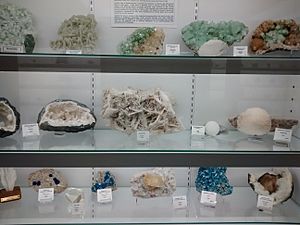Mineral and Lapidary Museum facts for kids
The Mineral and Lapidary Museum of Henderson County is a special place in Hendersonville, North Carolina. It's a non-profit museum, which means it's run by volunteers and doesn't aim to make money. It first opened in 1997. You can find it right in the middle of the city's Historic District.
This museum is located in Western North Carolina, an area known for its amazing rocks and minerals in the Blue Ridge Mountains. People often call it The Geode-Cracking Museum because volunteers often crack geodes open for visitors to see what's inside!
The museum's main goal is to help kids in Henderson and nearby areas learn about Earth Science. This includes topics like Mineralogy (the study of minerals), Geology (the study of Earth's structure), Paleontology (the study of fossils), and Lapidary Arts (the art of cutting and polishing gemstones). The museum has many exhibits of local minerals and gemstones. They also have a workshop where you can watch people cut and polish gems.
The Henderson County Gem and Mineral Society helps run the museum. This group is a great resource for anyone who loves rock hounding, which is searching for rocks and minerals in nature. The museum is also a wonderful place for adults to learn more about our planet earth.
Contents
Exploring the Museum's Treasures
The museum is full of interesting things like gems, minerals, geodes, and fossils from all over the world. It's like a journey through Earth's history!
Amazing Rocks and Minerals
You can see many different stone and mineral samples from North Carolina. There's even a long wall showing off a local rock called Henderson Augen Gneiss.
One of the biggest attractions is a six-foot-tall purple amethyst geode from Brazil. It's huge! There are also more than two dozen pairs of colorful quartz and calcite geodes from Mexico.
Glowing Minerals
A very cool exhibit shows three dozen fluorescent minerals. These are minerals that glow under special light, like fluorite, opal, willemite, calcite, ruby, and sodalite. You can see how they glow using different types of ultraviolet light, sometimes called black light.
Famous Diamonds and Meteorites
The museum also has four copies of the famous Hope Diamond. One of these is a copy of the large 18th-century French Blue Diamond.
Nearby, you can see pieces of the 1901 Hendersonville iron-nickel meteorite. This is a real space rock that fell to Earth!
Ancient History and Artifacts
The museum also displays Native American archeological artifacts found in the area. For example, the Garden Creek site in Haywood County shows that people lived there as far back as 8000 BCE. There are also remains of old villages and earthwork mounds built by the Cherokee people.
Dinosaurs and Prehistoric Animals
Get ready to meet some ancient creatures! The museum has a copy of a Tyrannosaurus rex skull from the Cretaceous period, which was part of the Mesozoic era. There's also a skull of Smilodon, the big sabre-tooth cat from the Pleistocene epoch of the Cenozoic era. You can even see a copy of a tusk and femur (leg bone) from a prehistoric mastodon.
Kids are welcome to touch real (non-avian) dinosaur eggs! These fossilized eggs were laid by a duck-billed hadrosaur millions of years ago in China.
Petrified Wood
The museum has three giant tree trunks made of petrified wood. This means they turned into stone over a very long time. Visitors can even sit on these ancient tree trunks!
See also




